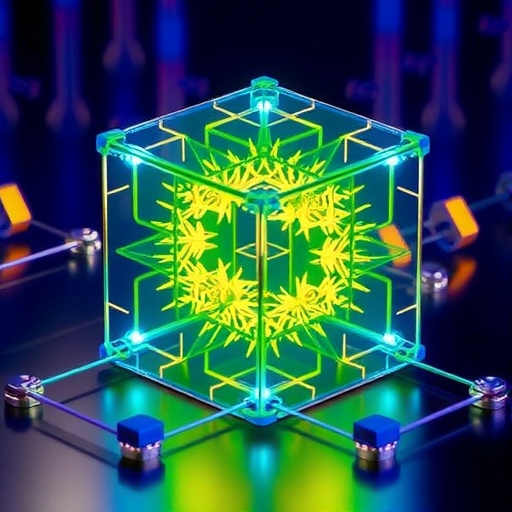In a significant leap forward for the field of quantum materials, scientists at the U.S. Naval Research Laboratory (NRL) have unveiled a groundbreaking technological innovation, the “cluster system.” This state-of-the-art system acts as a multifaceted platform that enables researchers to synthesize and analyze materials at the atomic level, all within a pristine vacuum environment. The implications of this advancement are profound, especially as it stands to expedite the exploration and development of advanced electronic materials, potentially heralding a new era in electronics.
The essence of the cluster system lies in its ability to grow materials with atomic precision, a process that had previously required multiple separate steps, often involving the transfer of samples between different instruments. Traditionally, researchers faced the arduous task of moving samples out of one apparatus to send them to another for analysis, which inherently came with risks of contamination and delays. By contrast, the NRL’s innovation consolidates this entire process under one roof, dramatically streamlining the research workflow.
Dr. Connie Li, a leading research scientist at NRL, expressed her enthusiasm about the innovative capabilities of the cluster system, invoking a sense of excitement akin to “Christmas came early.” The system empowers researchers to not only grow materials one atomic layer at a time but also to immediately examine their structures and electronic properties in situ. This capability is pivotal for understanding the intricate behaviors of quantum materials, shedding light on their applications in future technologies.
Central to the functionality of the cluster system is its integration of various growth and characterization techniques. All these methods coalesce around a central interface chamber, where a robotic transfer arm efficiently navigates samples between different chambers while maintaining an ultra-high vacuum environment. This seamless transition allows for uninterrupted experimentation, maximizing the potential for real-time observation and analysis.
The cluster system employs molecular beam epitaxy, a sophisticated technique that enables the precise deposition of materials at the atomic scale. This method is vital for the creation of new materials with unique properties, as it allows scientists to construct thin films of materials one atomic layer at a time, continuously monitoring the growth process. Coalescing growth with characterization means that researchers can observe modifications at the atomic level as they occur, enabling immediate adjustments and refinements to the growth process.
Additionally, the system incorporates advanced imaging and spectroscopy techniques to facilitate comprehensive analysis of the materials being developed. Tools such as scanning tunneling microscopy (STM) offer the capability to visualize individual atoms, while angle-resolved photoemission spectroscopy (ARPES) is employed to map out the electronic band structures of these new materials. These powerful techniques provide unprecedented insight into the electronic properties and structural integrity of the synthesized materials.
The transition from traditional research methodologies to the cluster system marks a paradigm shift in how materials are studied and understood. Previously, the need to transport materials for analysis would often introduce uncertainties and risks, which could lead to inconsistent results. The ability to monitor and refine the material growth process in real time, without the interruption and exposure to potentially contaminative environments, enhances the integrity and reliability of the research.
Focused on the realm of quantum materials, the research being conducted within the cluster system is most relevant to the exploration of superconductors and topological insulators. Superconductors are materials that can conduct electricity with zero resistance, presenting exciting opportunities for energy-efficient technologies. Meanwhile, topological insulators, which only conduct electricity on their surfaces, hold promise for robust electronic applications, resilient even in the presence of defects.
As the need for advanced electronic devices grows, the importance of these materials cannot be overstated. NRL’s groundbreaking work with the cluster system is poised to contribute substantially to the future of Navy and Department of Defense technologies. Innovations in memory storage, advanced sensors, and efficient electronics could fundamentally alter the landscape of technology as we know it, opening doors to new applications previously thought to be unattainable.
Dr. Olaf van ‘t Erve, also a research scientist at NRL, echoed Dr. Li’s sentiments, highlighting the system’s capability to produce materials that transcend the limitations of current silicon-based technologies. As researchers probe deeper into the unique properties offered by quantum materials, the potential applications span a wide array of fields, each promising to enhance operational efficiencies and technological prowess.
The installation of the cluster system is now complete, and it has reached operational status. Researchers at NRL are optimistic that this tool will significantly accelerate discoveries in quantum materials, shortening the timeline from fundamental scientific exploration to practical applications. This advancement could pave the way for innovative solutions that bolster the capabilities of both the Fleet and the Nation.
In essence, the unveiling of this cluster system represents a transformative moment in material science, one that blends cutting-edge technology with groundbreaking research methodologies. NRL’s commitment to pushing the boundaries of science once again reaffirms its role as a leader in the exploration of advanced materials. As scientists embark on this new journey of discovery, the opportunities seem boundless.
The field of quantum materials is at a crossroads, with NRL firmly positioned at the forefront. As researchers delve into this vibrant domain, the outcomes of their efforts may well redefine our understanding of electronic materials and, ultimately, the technology we rely on in the years to come.
Subject of Research: Quantum Materials Synthesis and Characterization
Article Title: Accelerating Discovery: The U.S. Naval Research Laboratory’s Innovative Cluster System
News Publication Date: September 9, 2025
Web References: Not available
References: Not available
Image Credits: U.S. Navy photo by Sarah Peterson
Keywords
Quantum materials, Superconductors, Topological insulators, Electronics, Molecular beam epitaxy, Scanning tunneling microscopy, Angle-resolved photoemission spectroscopy.




